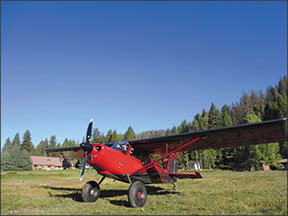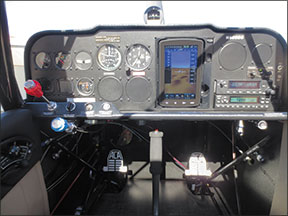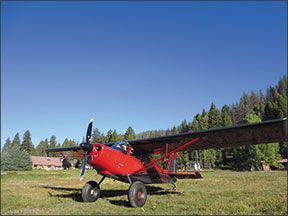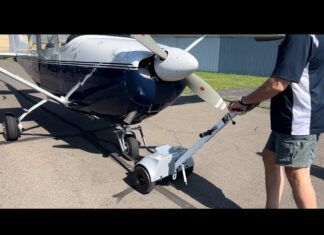Let’s begin with the conclusion: American Champion’s decision to add 30 HP to the long-serving, 180-HP Scout, to make what it calls the Denali Scout—created the stud brute of the two-place, backcountry airplane set. It keeps the honest handling and excellent ground manners of the Scout while notching up the climb rate from very good to nearly breathtaking. There are some shortcomings that we’ll outline—they are all carryovers from the original Scout and not safety of flight matters.

Systems, loading
Adding power to an established airframe to get better performance seems like a no-brainer when it comes to improving the breed, but power is destabilizing—the airframe and control system may need significant changes. Second, there really ain’t a free lunch—more power means more weight in the engine room, accommodating a different, probably bigger, prop and figuring out how to store and supply fuel for a hungrier engine. Oh, yeah, there is going to be a whole new vibration harmonic for the airframe to compensate for (cracked structure is no joke), and the empennage is going to have to absorb higher intensity power pulses with each passage of a prop blade.
After flying the Lycoming IO-360-A1B6-equipped Denali with the new four-into-one exhaust system, new metal cowling and new, larger horizontal tail with an airfoil, rather than flat, cross section, it seems to me American Champion engineers did a nice job of incorporating the power into the airframe.



The fuel system remains the same as the 180-HP Scout. It is a dirt-simple, off-on arrangement (accident data has long shown off/on systems to be the safest) with 35 gallons of usable fuel in two wing tanks. Thirty-five gallons isn’t much—so there is an optional system that adds another 35 gallons of usable fuel by plumbing in a second tank just outboard of the standard tank in each wing (apparently almost all buyers order the extra tankage).
The inboard and outboard tanks are connected by three fuel lines—smaller ones down low, fore and aft, and a three-inch line near the middle of the tank. The four tanks are also connected at the top of each by a line that goes to a single fuel vent below the right wing. The fuel caps are not vented. From a belt and suspenders perspective, I’d like to see a secondary vent.
The fuel fillers are located in the outboard tanks of the optional system—so as the tanks are filled, the fuel flows from the outboard into the inboard tanks due to wing dihedral. Because fuel can be added faster than it can flow into the inboard tank, to completely fill the tanks, it may be necessary to wait a few minutes after a tank first appears to be full, and then add more to top it off. Seventy gallons gives excellent endurance, but filling the tanks in the Denali Scout I flew meant the airplane was single-place—only 288 pounds could be carried in the cabin. The Denali Scout has what I consider to be a very good useful load—708 pounds in the one I examined. With two 200-pounders in the seats, 51 gallons of fuel could be carried, plenty for most flights.


The problem I ran into was figuring out how much fuel was in the airplane. The float-type gauging system gives a rough estimate of quantity and does clearly show when the fuel is getting low, but that’s it. I suspect owners will either create measuring dip sticks for preflight, order the optional JPI EDM-930 Engine Data Management System and track fuel flow and quantity added, or simply add fuel until “it looks about right” and accept that they may be flying over gross.
American Champion will install just about any avionics package a buyer desires, from bare bones through an Aspen glass panel. The basic airplane includes just VFR instrumentation—not even including a slip-skid ball, something I think is essential.
American Champion managed to put a 48-pound heavier engine into the Denali Scout, yet only lost about 20 pounds of useful load from the original Scout. Both have the same, 2150-pound gross weight.
There is no issue with running out of the front end of the c.g. range when flying solo, with no baggage.
I did a number of weight-and-balance calculations and did not run into fore or aft limitations with any loading combination. The main baggage compartment has a 10.4-cubic-foot capacity and can carry 100 pounds. The airplane I flew had the optional 3.6-cubic-foot extended aft baggage area that holds 30 pounds.
Fit, Finish AND FLYING
The fit and finish of the airplane was very good—far better than new airplanes used to be—but not quite to the level that is expected for a current new airplane that costs we’ll into six figures. There was some overspray on interior panels and a mismatch on some interior colors. When a new $40,000 truck has virtually perfect fit and finish, I think it’s reasonable that a quarter-million-dollar airplane be at the same level.
While we’re talking about pricing, the base price for the Denali Scout is $249,000, $23,000 more than the 180-HP Scout and competitive for new airplanes in its peer group.
The airplane I flew had a number of options, including 31-inch bush wheels, wide rear seat, extended baggage, long-range tanks and a basic avionics package. It was priced at $259,000.
I have always thought we’ll of American Champion’s crashworthiness design. Fuel is contained in metal tanks that are located between the wing spars. The Denali I flew had a five-point restraint system and the quick-release cabin door. Being able to jettison the door prior to a forced landing, in my opinion, increases the chances for the occupants to get safely out of the airplane after it stops.
In working with American Champion to set up this review, it was recommended that I fly the Denali Scout in the backcountry where it could show what it could do. I flew it into the Idaho wilderness, including a stop at Sulfur Creek Ranch, with Kasey Lindsay, an experienced off-airport pilot and American Champion dealer.
The walk-around inspection of the Denali is conventional; there are six fuel drains with the long-range tanks, and you need a screwdriver to open the cowling halves. The Scout sits high normally; due to its beefed-up landing gear for better prop clearance—but the 31-inch Alaskan bush wheels really made this Denali stand tall.
Nevertheless, boarding was easy—far easier than a Super Cub—with the step in the right place and plenty of room to maneuver into either seat. There was plenty of shoulder and head room and adequate leg room in both seats. With adjustble seats, my 6 ft 4 in.
BACKCOUNTRY AIRPLANES: ATTRIBUTES
Lot’s of airplanes are alleged to be good for backcountry operations by pilots who want to seriously recreate. Most of them have been reviewed in this magazine.
The Denali Scout I flew for this review was made available by Northwest Backcountry Aircraft of Nampa, Idaho—and I spent an extended period speaking with the proprietors, Kasey Lindsay and Bob Hannah, experienced backcountry pilots, about what makes a good airplane for that type of flying. I’ve combined their thoughts along with reviews in this magazine of rugged, utility airplanes, to come up with a list of attributes of a good backcountry airplane.
Landing gear strength and stability. It has to absorb punishment from solid touchdowns as we’ll as ever-present rocks, brush and holes. The brake lines should be protected, as there’s a good chance a gear leg is going to strike something that could break an exposed brake line.
The gear geometry should make ground handling as easy as possible and minimize the risk of nose over in tailwheel airplanes. The most common cause of accidents in backcountry flying is loss of control on landing—gear design matters.
Good visibility over the nose during all phases of landing and takeoff. Hitting obstructions short of the the runway and just after liftoff are common cause of backcountry accidents. An airplane that has the nose block forward visibility is at risk of hitting something. The nosewheel King Katmai is proving popular partially because of its good visibility over the nose. The design of a tailwheel airplane should allow a competent pilot to apply the brakes while the tail is off of the ground to allow good visibility over the nose and maximize deceleration.
Suitable stability in pitch to allow precise speed control on final.
Flaps should provide high drag and rapid deceleration so the airplane doesn’t float if the pilot isn’t perfect with airspeed control.
A design that allows installation of oversize tires.
Power. Lots of it. When things go wrong, the ability to climb steeply and rapidly may mean everything. As Kasey Lindsay put it, the airplane has to be able to “climb like a rocket and come out of the sky like a piano.”
No nasty behavior in a slip—and the ability slip steeply, hold the slip into the flare and straighten out at the last moment.
Good prop clearance, high wing for brush clearance, plus good overall visibility. When maneuvering for a runway in a canyon, a skylight means you can see what you need to see in a steep turn. Having lots of window area, with few bars and posts that can get in the way is important—especially when looking down and aft, something you do surprisingly often.
Excellent control response in gusty crosswinds and the ability to pin the airplane after landing so a gust doesn’t put it back into the air.
Easy access to the flap control.
Easy to use, fast-acting trim system.
The ability to go around at the last possible moment, without a lot of trim change when going to full power in landing configuration—you don’t want to have to be stiff-arming the stick or yoke while you’re trying to get maximum performance out of the airplane.
A good mix between STOL ability and cruise speed. Sacrificing everything for STOL means a slow airplane in cruise. The ideal backcountry airplane will handle a 500-foot strip safely and get there and back home without having to time the trip with a calendar or worry about running out of fuel.


